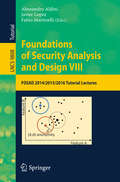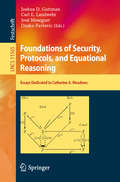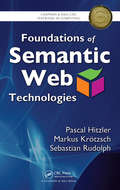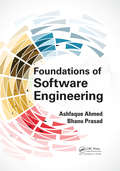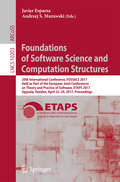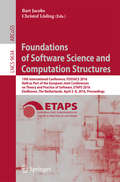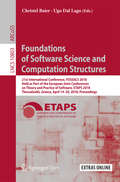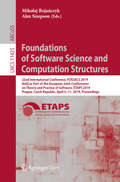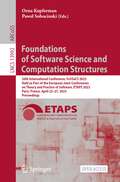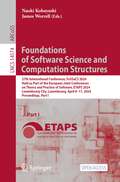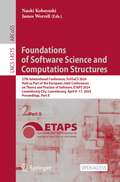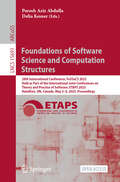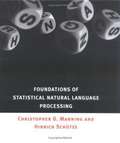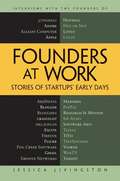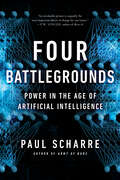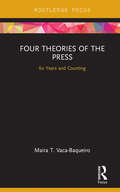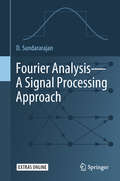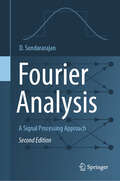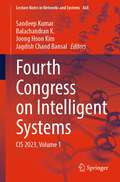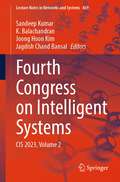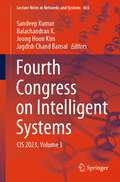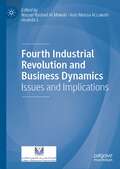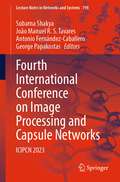- Table View
- List View
Foundations of Security Analysis and Design VIII
by Alessandro Aldini Javier Lopez Fabio MartinelliFOSAD has been one of the foremost educational events established with the goal of disseminating knowledge in the critical area of security in computer systems and networks. Over the years, both the summer school and the book series have represented a reference point for graduate students and young researchers from academia and industry, interested to approach the field, investigate open problems, and follow priority lines of research. This book presents thoroughly revised versions of four tutorial lectures given by leading researchers during three International Schools on Foundations of Security Analysis and Design, FOSAD, held in Bertinoro, Italy, in September 2014, 2015 and 2016. The topics covered in this book include zero-knowledge proof systems, JavaScript sandboxing, assessment of privacy, and distributed authorization.
Foundations of Security, Protocols, and Equational Reasoning: Essays Dedicated to Catherine A. Meadows (Lecture Notes in Computer Science #11565)
by Joshua D. Guttman Carl E. Landwehr José Meseguer Dusko PavlovicThis Festschrift volume is published in honor of Catherine A. Meadows and contains essays presented at the Catherine Meadows Festschrift Symposium held in Fredericksburg, VA, USA, in May 2019.Catherine A. Meadows has been a pioneer in developing symbolic formal verification methods and tools. Her NRL Protocol Analyzer, a tool and methodology that embodies symbolic model checking techniques, has been fruitfully applied to the analysis of many protocols and protocol standards and has had an enormous influence in the field. She also developed a new temporal logic to specify protocol properties, as well as new methods for analyzing various kinds of properties beyond secrecy such as authentication and resilience under Denial of Service (DoS) attacks and has made important contributions in other areas such as wireless protocol security, intrusion detection, and the relationship between computational and symbolic approaches to cryptography. This volume contains 14 contributions authored by researchers from Europe and North America. They reflect on the long-term evolution and future prospects of research in cryptographic protocol specification and verification.
Foundations of Semantic Web Technologies (Chapman & Hall/CRC Textbooks in Computing)
by Sebastian Rudolph Pascal Hitzler Markus KrotzschThoroughly covering basic introductions and intuitions, technical details, and formal foundations, this text focuses on the established foundations in this area that have become relatively stable over time. It presents the latest developments in Semantic Web standards, including RDF, RDF Schema, OWL 2, RIF, and SPARQL. It also explores formal semantics, OWL querying, the relationship between rules and OWL, and ontology engineering and applications.
Foundations of Soft Logic
by Oded Maimon Moshe KleinThis book presents a groundbreaking new mathematical paradigm and system (including inventing a new number) that enables a new approach to advancing the foundations of science and technology. The new approach allows connecting subjective and objective points of view that do not rely solely on the classical deductive approach. There is no need to fear paradoxical situations, because it’s precisely in them wherein lies the key to a new understanding that is more connected to life itself. This new model also serves to advance the theory of consciousness. Life is more colorful and diverse than just the binary colors of black and white. For this purpose, the authors propose a new type of number called Soft Number. The basic idea is to distinguish between the different multiples of the number zero. Soft Logic is a continuous extension of the idea of giving different meanings to the zero. The authors create a tangible model of an infinitely small world. This seemingly inconceivable world is important for understanding the essence of the connection between the external world of reality and the inner world of human beings and offers a new language to express it. This book systematically and axiomatically describes the mathematical development of Soft Logic and Soft Numbers and points to possible directions for scientific and technological applications. This book is a valuable resource for researchers working in mathematics, physics, biology, engineering, computer science and artificial intelligence as well as advanced-level students majoring in computer science, engineering and mathematics. Practitioners, Data Scientists, AI developers and readers interested in a scientific understanding of the concept of consciousness will also want to purchase this book.
Foundations of Software Engineering
by Ashfaque Ahmed Bhanu PrasadThe best way to learn software engineering is by understanding its core and peripheral areas. Foundations of Software Engineering provides in-depth coverage of the areas of software engineering that are essential for becoming proficient in the field. The book devotes a complete chapter to each of the core areas. Several peripheral areas are also explained by assigning a separate chapter to each of them. Rather than using UML or other formal notations, the content in this book is explained in easy-to-understand language. Basic programming knowledge using an object-oriented language is helpful to understand the material in this book. The knowledge gained from this book can be readily used in other relevant courses or in real-world software development environments.This textbook educates students in software engineering principles. It covers almost all facets of software engineering, including requirement engineering, system specifications, system modeling, system architecture, system implementation, and system testing. Emphasizing practical issues, such as feasibility studies, this book explains how to add and develop software requirements to evolve software systems.This book was written after receiving feedback from several professors and software engineers. What resulted is a textbook on software engineering that not only covers the theory of software engineering but also presents real-world insights to aid students in proper implementation. Students learn key concepts through carefully explained and illustrated theories, as well as concrete examples and a complete case study using Java. Source code is also available on the book’s website. The examples and case studies increase in complexity as the book progresses to help students build a practical understanding of the required theories and applications.
Foundations of Software Science and Computation Structures
by Javier Esparza Andrzej S. MurawskiThis book constitutes the proceedings of the 20th International Conference on Foundations of Software Science and Computation Structures, FOSSACS 2017, which took place in Uppsala, Sweden in April 2017, held as Part of the European Joint Conferences on Theory and Practice of Software, ETAPS 2017. The 32 papers presented in this volume were carefully reviewed and selected from 101 submissions. They were organized in topical sections named: coherence spaces and higher-order computation; algebra and coalgebra; games and automata; automata, logic and formal languages; proof theory; probability; concurrency; lambda calculus and constructive proof; and semantics and category theory.
Foundations of Software Science and Computation Structures
by Bart Jacobs Christof LödingThis book constitutes the proceedings of the 19thInternational Conference on Foundations of Software Science and ComputationStructures, FOSSACS 2016, which took place in Eindhoven, The Netherlands, inApril 2016, held as Part of the European Joint Conferences on Theory andPractice of Software, ETAPS 2016. The 31 full papers presented in this volume werecarefully reviewed and selected from 85 submissions. They were organized intopical sections named: types; recursion and fixed-points; verification andprogram analysis; automata, logic, games; probabilistic and timed systems;proof theory and lambda calculus; algorithms for infinite systems; and monads.
Foundations of Software Science and Computation Structures: 21st International Conference, Fossacs 2018, Held As Part Of The European Joint Conferences On Theory And Practice Of Software, Etaps 2018, Thessaloniki, Greece, April 14-20, 2018. Proceedings (Lecture Notes in Computer Science #10803)
by Ugo Dal Lago Christel BaierThis book constitutes the proceedings of the 21st International Conference on Foundations of Software Science and Computational Structures, FOSSACS 2018, which took place in Thessaloniki, Greece, in April 2018, held as part of the European Joint Conference on Theory and Practice of Software, ETAPS 2018.The 31 papers presented in this volume were carefully reviewed and selected from 103 submissions. The papers are organized in topical sections named: semantics; linearity; concurrency; lambda-calculi and types; category theory and quantum control; quantitative models; logics and equational theories; and graphs and automata.
Foundations of Software Science and Computation Structures: 22nd International Conference, FOSSACS 2019, Held as Part of the European Joint Conferences on Theory and Practice of Software, ETAPS 2019, Prague, Czech Republic, April 6–11, 2019, Proceedings (Lecture Notes in Computer Science #11425)
by Mikołaj Bojańczyk Alex SimpsonThis open access book constitutes the proceedings of the 22nd International Conference on Foundations of Software Science and Computational Structures, FOSSACS 2019, which took place in Prague, Czech Republic, in April 2019, held as part of the European Joint Conference on Theory and Practice of Software, ETAPS 2019.The 29 papers presented in this volume were carefully reviewed and selected from 85 submissions. They deal with foundational research with a clear significance for software science.
Foundations of Software Science and Computation Structures: 26th International Conference, FoSSaCS 2023, Held as Part of the European Joint Conferences on Theory and Practice of Software, ETAPS 2023, Paris, France, April 22–27, 2023, Proceedings (Lecture Notes in Computer Science #13992)
by Orna Kupferman Pawel SobocinskiThis open access book constitutes the proceedings of the 26th International Conference on Foundations of Software Science and Computational Structures, FOSSACS 2023, which was held during April 22-27, 2023, in Paris, France, as part of the European Joint Conferences on Theory and Practice of Software, ETAPS 2023. The 26 regular papers presented in this volume were carefully reviewed and selected from 85 submissions. They deal with research on theories and methods to support the analysis, integration, synthesis, transformation, and verification of programs and software systems.
Foundations of Software Science and Computation Structures: 27th International Conference, FoSSaCS 2024, Held as Part of the European Joint Conferences on Theory and Practice of Software, ETAPS 2024, Luxembourg City, Luxembourg, April 6–11, 2024, Proceedings, Part I (Lecture Notes in Computer Science #14574)
by James Worrell Naoki KobayashiThe two open access volumes LNCS 14574 and 14575 constitute the proceedings of the 27th International Conference on Foundations of Software Science and Computation Structures, FOSSACS 2024, which took place in Luxembourg in April 2024.The 24 full papers included in this book were carefully reviewed and selected from 79 submissions. They were organized in topical sections as follows: Part I: Infinite games; categorical semantics; automata and synthesis; Part II: Types and programming languages; logic and proofs; infinite-state systems.
Foundations of Software Science and Computation Structures: 27th International Conference, FoSSaCS 2024, Held as Part of the European Joint Conferences on Theory and Practice of Software, ETAPS 2024, Luxembourg City, Luxembourg, April 6–11, 2024, Proceedings, Part II (Lecture Notes in Computer Science #14575)
by James Worrell Naoki KobayashiThe two open access volumes LNCS 14574 and 14575 constitute the proceedings of the 27th International Conference on Foundations of Software Science and Computation Structures, FOSSACS 2024, which took place in Luxembourg in April 2024.The 24 full papers included in this book were carefully reviewed and selected from 79 submissions. They were organized in topical sections as follows: Part I: Infinite games; categorical semantics; automata and synthesis; Part II: Types and programming languages; logic and proofs; infinite-state systems.
Foundations of Software Science and Computation Structures: 28th International Conference, FoSSaCS 2025, Held as Part of the International Joint Conferences on Theory and Practice of Software, ETAPS 2025, Hamilton, ON, Canada, May 3–8, 2025, Proceedings (Lecture Notes in Computer Science #15691)
by Parosh Aziz Abdulla Delia KesnerThis open access book constitutes the proceedings of the 28th International Conference on Foundations of Software Science and Computation Structures, FOSSACS 2025, which took place in Hamilton, Canada, during May 2025, held as part of the International Joint Conferences on Theory and Practice of Software, ETAPS 2025. The 19 papers included in these proceedings were carefully reviewed and selected from 58 submissions. They focus on foundational research in software science on theories and methods to support the analysis, integration, synthesis, transformation, and verification of programs and software systems.
Foundations of Statistical Natural Language Processing
by Christopher D. Manning Hinrich SchutzeAs a comprehensive introduction to statistical natural language processing it contains all the theory and algorithms needed for building NLP tools and covers collocation finding, word sense disambiguation, probabilistic parsing, information retrieval, and other applications.
Foundations of Wavelet Networks and Applications
by S. Sitharama Iyengar V.V. PhohaTraditionally, neural networks and wavelet theory have been two separate disciplines, taught separately and practiced separately. In recent years the offspring of wavelet theory and neural networks-wavelet networks-have emerged and grown vigorously both in research and applications. Yet the material needed to learn or teach wavelet networks has remained scattered in various research monographs.Foundations of Wavelet Networks and Applications unites these two fields in a comprehensive, integrated presentation of wavelets and neural networks. It begins by building a foundation, including the necessary mathematics. A transitional chapter on recurrent learning then leads to an in-depth look at wavelet networks in practice, examining important applications that include using wavelets as stock market trading advisors, as classifiers in electroencephalographic drug detection, and as predictors of chaotic time series. The final chapter explores concept learning and approximation by wavelet networks.The potential of wavelet networks in engineering, economics, and social science applications is rich and still growing. Foundations of Wavelet Networks and Applications prepares and inspires its readers not only to help ensure that potential is achieved, but also to open new frontiers in research and applications.
Founders at Work: Stories of Startups' Early Days
by Jessica LivingstonFounders at Work: Stories of Startups' Early Days is a collection of interviews with founders of famous technology companies about what happened in the very earliest days. These people are celebrities now.
Four Battlegrounds: Power In The Age Of Artificial Intelligence
by Paul ScharreAn NPR 2023 "Books We Love" Pick One of the Next Big Idea Club's Must-Read Books "An invaluable primer to arguably the most important driver of change for our future." —P. W. Singer, author of Burn-In An award-winning defense expert tells the story of today’s great power rivalry—the struggle to control artificial intelligence. A new industrial revolution has begun. Like mechanization or electricity before it, artificial intelligence will touch every aspect of our lives—and cause profound disruptions in the balance of global power, especially among the AI superpowers: China, the United States, and Europe. Autonomous weapons expert Paul Scharre takes readers inside the fierce competition to develop and implement this game-changing technology and dominate the future. Four Battlegrounds argues that four key elements define this struggle: data, computing power, talent, and institutions. Data is a vital resource like coal or oil, but it must be collected and refined. Advanced computer chips are the essence of computing power—control over chip supply chains grants leverage over rivals. Talent is about people: which country attracts the best researchers and most advanced technology companies? The fourth “battlefield” is maybe the most critical: the ultimate global leader in AI will have institutions that effectively incorporate AI into their economy, society, and especially their military. Scharre’s account surges with futuristic technology. He explores the ways AI systems are already discovering new strategies via millions of war-game simulations, developing combat tactics better than any human, tracking billions of people using biometrics, and subtly controlling information with secret algorithms. He visits China’s “National Team” of leading AI companies to show the chilling synergy between China’s government, private sector, and surveillance state. He interviews Pentagon leadership and tours U.S. Defense Department offices in Silicon Valley, revealing deep tensions between the military and tech giants who control data, chips, and talent. Yet he concludes that those tensions, inherent to our democratic system, create resilience and resistance to autocracy in the face of overwhelmingly powerful technology. Engaging and direct, Four Battlegrounds offers a vivid picture of how AI is transforming warfare, global security, and the future of human freedom—and what it will take for democracies to remain at the forefront of the world order.
Four Theories of the Press: 60 Years and Counting
by Maira T. Vaca-BaqueiroThe links between distinctive political regimes and media systems are undeniable. As Siebert, Peterson and Schramm wrote (1956: 1) 60 years ago: ‘the press always takes on the form and coloration of the social and political structures within which it operates’. Nevertheless, today’s world and politics are completely different from the bipolar era that inspired the ground breaking Four Theories of the Press. What are the main changes and continuities that have driven the study of politics and the media in the last decades? How to approach this interaction in the light of the challenges that democracy is facing or the continuing technological revolution that at times hampers the media?This provocative book explores the main premises that have guided the study of politics and the media in the last decades. In so doing, it gives the reader key analytical tools to question the sustainability of past categorizations that no longer match up with current developments of both, political regimes and the media. In searching for clarification about current discrepancies between democracies and media’s distinctive structures or purposes, Four Theories of the Press: 60 Years and Counting puts forward an alternative premise: the political-media complex.
Fourier Analysis—A Signal Processing Approach
by D. SundararajanThis book sheds new light on Transform methods, which dominate the study of linear time-invariant systems in all areas of science and engineering, such as circuit theory, signal/image processing, communications, controls, vibration analysis, remote sensing, biomedical systems, optics and acoustics. It presents Fourier analysis primarily using physical explanations with waveforms and/or examples, only using mathematical formulations to the extent necessary for its practical use. Intended as a textbook for senior undergraduates and graduate level Fourier analysis courses in engineering and science departments, and as a supplementary textbook for a variety of application courses in science and engineering, the book is also a valuable reference for anyone – student or professional – specializing in practical applications of Fourier analysis. The prerequisite for reading this book is a sound understanding of calculus, linear algebra, signals and systems, and programming at the undergraduate level.
Fourier Analysis—A Signal Processing Approach
by D. SundararajanThis book sheds new light on Transform methods, which dominate the study of linear time-invariant systems in all areas of science and engineering, such as circuit theory, signal/image processing, communications, controls, vibration analysis, remote sensing, biomedical systems, optics, and acoustics. It presents Fourier analysis primarily using physical explanations with waveforms and/or examples, only using mathematical formulations to the extent necessary for its practical use. Intended as a textbook for senior undergraduates and graduate-level Fourier analysis courses in engineering and science departments, and as a supplementary textbook for a variety of application courses in science and engineering, the book is also a valuable reference for anyone – student or professional – specializing in practical applications of Fourier analysis. The prerequisite for reading this book is a sound understanding of calculus, linear algebra, signals and systems, and programming at the undergraduate level. Review of last version “The Fourier analysis is mainly presented from a practical point of view, where the mathematical theory is very simplified. This book is mainly written for broad readership of graduate students and researchers in physics, computer science, and engineering with special interest in signal processing. … Doubtless, this textbook will stimulate the practical education in the Fourier analysis and its applications in signal processing.” (Manfred Tasche, zbMATH 1407.94002, 2019)
Fourth Congress on Intelligent Systems: CIS 2023, Volume 1 (Lecture Notes in Networks and Systems #868)
by Sandeep Kumar Jagdish Chand Bansal Joong Hoon Kim Balachandran K.This book is a collection of selected papers presented at the Fourth Congress on Intelligent Systems (CIS 2023), organized by CHRIST (Deemed to be University), Bangalore, India, under the technical sponsorship of the Soft Computing Research Society, India, during September 4–5, 2023. It includes novel and innovative work from experts, practitioners, scientists, and decision-makers from academia and industry. It covers topics such as the Internet of Things, information security, embedded systems, real-time systems, cloud computing, big data analysis, quantum computing, automation systems, bio-inspired intelligence, cognitive systems, cyber-physical systems, data analytics, data/web mining, data science, intelligence for security, intelligent decision-making systems, intelligent information processing, intelligent transportation, artificial intelligence for machine vision, imaging sensors technology, image segmentation, convolutional neural network, image/video classification, soft computing for machine vision, pattern recognition, human-computer interaction, robotic devices and systems, autonomous vehicles, intelligent control systems, human motor control, game playing, evolutionary algorithms, swarm optimization, neural network, deep learning, supervised learning, unsupervised learning, fuzzy logic, rough sets, computational optimization, and neuro-fuzzy systems.
Fourth Congress on Intelligent Systems: CIS 2023, Volume 2 (Lecture Notes in Networks and Systems #869)
by K. Balachandran Sandeep Kumar Jagdish Chand Bansal Joong Hoon KimThis book is a collection of selected papers presented at the Fourth Congress on Intelligent Systems (CIS 2023), organized by CHRIST (Deemed to be University), Bangalore, India, under the technical sponsorship of the Soft Computing Research Society, India, during September 4–5, 2023. It includes novel and innovative work from experts, practitioners, scientists, and decision-makers from academia and industry. It covers topics such as the Internet of Things, information security, embedded systems, real-time systems, cloud computing, big data analysis, quantum computing, automation systems, bio-inspired intelligence, cognitive systems, cyber-physical systems, data analytics, data/web mining, data science, intelligence for security, intelligent decision-making systems, intelligent information processing, intelligent transportation, artificial intelligence for machine vision, imaging sensors technology, image segmentation, convolutional neural network, image/video classification, soft computing for machine vision, pattern recognition, human-computer interaction, robotic devices and systems, autonomous vehicles, intelligent control systems, human motor control, game playing, evolutionary algorithms, swarm optimization, neural network, deep learning, supervised learning, unsupervised learning, fuzzy logic, rough sets, computational optimization, and neuro-fuzzy systems.
Fourth Congress on Intelligent Systems: CIS 2023, Volume 3 (Lecture Notes in Networks and Systems #865)
by Sandeep Kumar Jagdish Chand Bansal Joong Hoon Kim Balachandran K.This book is a collection of selected papers presented at the Fourth Congress on Intelligent Systems (CIS 2023), organized by CHRIST (Deemed to be University), Bangalore, India, under the technical sponsorship of the Soft Computing Research Society, India, during September 4–5, 2023. It includes novel and innovative work from experts, practitioners, scientists, and decision-makers from academia and industry. It covers topics such as the Internet of Things, information security, embedded systems, real-time systems, cloud computing, big data analysis, quantum computing, automation systems, bio-inspired intelligence, cognitive systems, cyber-physical systems, data analytics, data/web mining, data science, intelligence for security, intelligent decision-making systems, intelligent information processing, intelligent transportation, artificial intelligence for machine vision, imaging sensors technology, image segmentation, convolutional neural network, image/video classification, soft computing for machine vision, pattern recognition, human-computer interaction, robotic devices and systems, autonomous vehicles, intelligent control systems, human motor control, game playing, evolutionary algorithms, swarm optimization, neural network, deep learning, supervised learning, unsupervised learning, fuzzy logic, rough sets, computational optimization, and neuro-fuzzy systems.
Fourth Industrial Revolution and Business Dynamics: Issues and Implications
by Nasser Rashad Al Mawali Anis Moosa Al Lawati Ananda SThe book explains strategic issues, trends, challenges, and future scenario of global economy in the light of Fourth Industrial Revolution. It consists of insightful scientific essays authored by scholars and practitioners from business, technology, and economics area. The book contributes to business education by means of research, critical and theoretical reviews of issues in Fourth Industrial Revolution.
Fourth International Conference on Image Processing and Capsule Networks: ICIPCN 2023 (Lecture Notes in Networks and Systems #798)
by Antonio Fernández-Caballero João Manuel R. S. Tavares Subarna Shakya George PapakostasThis book includes high-quality research papers presented at the Fourth International Conference on Image Processing and Capsule Networks (ICIPCN 2023), which is held in Bangkok, Thailand, during 10–11 August 2023. This book provides a collection of the state-of-the-art research attempts to tackle the challenges in image and signal processing from various novel and potential research perspectives. The book investigates feature extraction techniques, image enhancement methods, reconstruction models, object detection methods, recommendation models, deep and temporal feature analysis, intelligent decision support systems, and autonomous image detection models. In addition to this, the book also looks into the potential opportunities to monitor and control the global pandemic situations.
